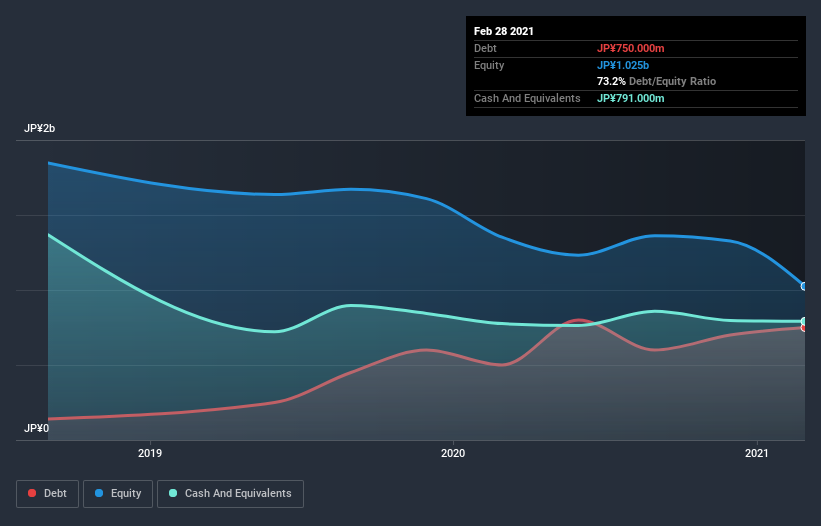
Howard Marks put it nicely when he said that, rather than worrying about share price volatility, 'The possibility of permanent loss is the risk I worry about... and every practical investor I know worries about.' It's only natural to consider a company's balance sheet when you examine how risky it is, since debt is often involved when a business collapses. As with many other companies ANAP Inc. (TYO:3189) makes use of debt. But is this debt a concern to shareholders?
When Is Debt A Problem?
Debt is a tool to help businesses grow, but if a business is incapable of paying off its lenders, then it exists at their mercy. Part and parcel of capitalism is the process of 'creative destruction' where failed businesses are mercilessly liquidated by their bankers. However, a more usual (but still expensive) situation is where a company must dilute shareholders at a cheap share price simply to get debt under control. Of course, plenty of companies use debt to fund growth, without any negative consequences. The first step when considering a company's debt levels is to consider its cash and debt together.
See our latest analysis for ANAP
What Is ANAP's Net Debt?
You can click the graphic below for the historical numbers, but it shows that as of February 2021 ANAP had JP¥713.0m of debt, an increase on JP¥500.0m, over one year. However, it does have JP¥791.0m in cash offsetting this, leading to net cash of JP¥78.0m.

How Strong Is ANAP's Balance Sheet?
The latest balance sheet data shows that ANAP had liabilities of JP¥1.18b due within a year, and liabilities of JP¥359.0m falling due after that. On the other hand, it had cash of JP¥791.0m and JP¥237.0m worth of receivables due within a year. So it has liabilities totalling JP¥515.0m more than its cash and near-term receivables, combined.
ANAP has a market capitalization of JP¥1.61b, so it could very likely raise cash to ameliorate its balance sheet, if the need arose. But we definitely want to keep our eyes open to indications that its debt is bringing too much risk. While it does have liabilities worth noting, ANAP also has more cash than debt, so we're pretty confident it can manage its debt safely. The balance sheet is clearly the area to focus on when you are analysing debt. But it is ANAP's earnings that will influence how the balance sheet holds up in the future. So if you're keen to discover more about its earnings, it might be worth checking out this graph of its long term earnings trend.
Over 12 months, ANAP made a loss at the EBIT level, and saw its revenue drop to JP¥5.3b, which is a fall of 14%. That's not what we would hope to see.
So How Risky Is ANAP?
We have no doubt that loss making companies are, in general, riskier than profitable ones. And the fact is that over the last twelve months ANAP lost money at the earnings before interest and tax (EBIT) line. And over the same period it saw negative free cash outflow of JP¥134m and booked a JP¥404m accounting loss. Given it only has net cash of JP¥78.0m, the company may need to raise more capital if it doesn't reach break-even soon. Summing up, we're a little skeptical of this one, as it seems fairly risky in the absence of free cashflow. When analysing debt levels, the balance sheet is the obvious place to start. But ultimately, every company can contain risks that exist outside of the balance sheet. For instance, we've identified 4 warning signs for ANAP (1 is a bit unpleasant) you should be aware of.
When all is said and done, sometimes its easier to focus on companies that don't even need debt. Readers can access a list of growth stocks with zero net debt 100% free, right now.
If you’re looking to trade ANAP, open an account with the lowest-cost* platform trusted by professionals, Interactive Brokers. Their clients from over 200 countries and territories trade stocks, options, futures, forex, bonds and funds worldwide from a single integrated account. Promoted
New: Manage All Your Stock Portfolios in One Place
We've created the ultimate portfolio companion for stock investors, and it's free.
• Connect an unlimited number of Portfolios and see your total in one currency
• Be alerted to new Warning Signs or Risks via email or mobile
• Track the Fair Value of your stocks
This article by Simply Wall St is general in nature. It does not constitute a recommendation to buy or sell any stock, and does not take account of your objectives, or your financial situation. We aim to bring you long-term focused analysis driven by fundamental data. Note that our analysis may not factor in the latest price-sensitive company announcements or qualitative material. Simply Wall St has no position in any stocks mentioned.
*Interactive Brokers Rated Lowest Cost Broker by StockBrokers.com Annual Online Review 2020
Have feedback on this article? Concerned about the content? Get in touch with us directly. Alternatively, email editorial-team (at) simplywallst.com.
About TSE:3189
Medium-low with weak fundamentals.
Market Insights
Community Narratives



